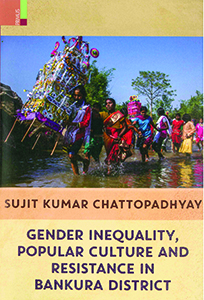
Gender Inequality, Popular Culture and Resistance in Bankura District
AUTHOR-Sujit Kumar Chattopadhyay
| HB ₹1495 . $64.95 . ₤42.95 |
||
INFORMATION
- AUTHOR : Sujit Kumar Chattopadhyay
- HB ISBN : 978-93-84082-15-4
- EBOOK ISBN : 978-93-84092-14-6
- Year : 2016
- Extent : xiv + 258 pp.
- Discount available on checkout
- Usually dispatched within 3 to 5 working days.
Gender Inequality, Popular Culture and Resistance
| HB ₹ 1495 . $ . ₤ |
PB ₹ . $ . ₤ |
|
| POD ₹ . $ . ₤ |
e-Book ₹ . $ . ₤ |
INFORMATION
- AUTHOR : Sujit Kumar Chattopadhyay
- HB ISBN : 1495
- PB ISBN :
- POD ISBN :
- ISBN : 978-93-84082-15-4
- Year : 2016
- Extent : xiv + 258
- 10% discount + free shipping
- Usually dispatched within 3 to 5 working days.
This book examines the connections and interrelationships at play between gender inequality, popular culture and resistance on the basis of case studies conducted in the district of Bankura, an area well known for its tradition and variety of popular culture. In contemporary India, gender-based prejudice is perhaps the most pervasive form of inequality, arguably more so in the rural society of Bengal where the deep rooted and complex forms of gender inequality are largely reproduced and legitimized in popular culture. Gender Inequality, Popular Culture and Resistance in Bankura District argues that if the exercise of power inherently involves resistance, then gender power is countered by some aspects of popular culture in favour of a more equitable relationship between men and women. The text also examines resistance to the ideological forms of gender bias and inequality depicted in popular culture such as folk songs, riddles, rhymes and proverbs operative in the rural society of Bankura and explores the intimate connection between popular culture and the everyday life of the general population.
The Author
Sujit Kumar Chattopadhyay is ex-chairman of the West Bengal Regional School Service Commission (Western Region). He was Associate Professor and Head of the Department of Political Science at the Bankura Zilla Saradamani Mahila Mahavidyapith, Bankura. His published works include Revisiting Vivekananda: From Revival to Renaissance (2015), and the edited volume Politics of Discrimination and the Problem of Democratic Governance in India: Issues, Experiences and Challenges (2009). He is also the author of an anthology of Bengali poems and several texts on gender and folklore.
This book examines the connections and interrelationships at play between gender inequality, popular culture and resistance on the basis of case studies conducted in the district of Bankura, an area well known for its tradition and variety of popular culture. In contemporary India, gender-based prejudice is perhaps the most pervasive form of inequality, arguably more so in the rural society of Bengal where the deep rooted and complex forms of gender inequality are largely reproduced and legitimized in popular culture. Gender Inequality, Popular Culture and Resistance in Bankura District argues that if the exercise of power inherently involves resistance, then gender power is countered by some aspects of popular culture in favour of a more equitable relationship between men and women. The text also examines resistance to the ideological forms of gender bias and inequality depicted in popular culture such as folk songs, riddles, rhymes and proverbs operative in the rural society of Bankura and explores the intimate connection between popular culture and the everyday life of the general population.
The Author
Sujit Kumar Chattopadhyay is ex-chairman of the West Bengal Regional School Service Commission (Western Region). He was Associate Professor and Head of the Department of Political Science at the Bankura Zilla Saradamani Mahila Mahavidyapith, Bankura. His published works include Revisiting Vivekananda: From Revival to Renaissance (2015), and the edited volume Politics of Discrimination and the Problem of Democratic Governance in India: Issues, Experiences and Challenges (2009). He is also the author of an anthology of Bengali poems and several texts on gender and folklore.
Table of Contents
Table of Contents
| List Of Abbreviations | Ix |
| List Of Tables, Figures And Maps | xi-xii |
| Preface | xiii-xiv |
| Introduction Defining The Problem: Current Knowledge, Sources And Methods | 1-18 |
| Gender Inequality: Concepts And Approaches | 19-39 |
| Defining Popular Culture—Various Concepts:Role Of Popular Culture And Social Resistance | 40-67 |
| Demographic, Social And Cultural Account Of The District Of Bankura And Various Forms Of Popular Culture | |
| Popular Culture And Gender Inequality In Bankura:Folk Songs | 105-135 |
| Popular Culture And Gender Inequality In Bankura:Riddles, Rhymes And Proverbs | 136-171 |
| Recent Challenges To Gender Inequality | 172-207 |
| Conclusion: Findings, Evaluation And Further Thoughts | 208-221 |
| Glossary | 223-224 |
| Bibliography | 225-241 |
| Index | 243-257 |
Lorem Ipsum is simply dummy text of the printing and typesetting industry. Lorem Ipsum has been the industry’s standard dummy text ever since the 1500s
Lorem Ipsum is simply dummy text of the printing and typesetting industry. Lorem Ipsum has been the industry’s standard dummy text ever since the 1500s
Lorem Ipsum is simply dummy text of the printing and typesetting industry. Lorem Ipsum has been the industry’s standard dummy text ever since the 1500s
Lorem Ipsum is simply dummy text of the printing and typesetting industry. Lorem Ipsum has been the industry’s standard dummy text ever since the 1500s
Lorem Ipsum is simply dummy text of the printing and typesetting industry. Lorem Ipsum has been the industry’s standard dummy text ever since the 1500s




